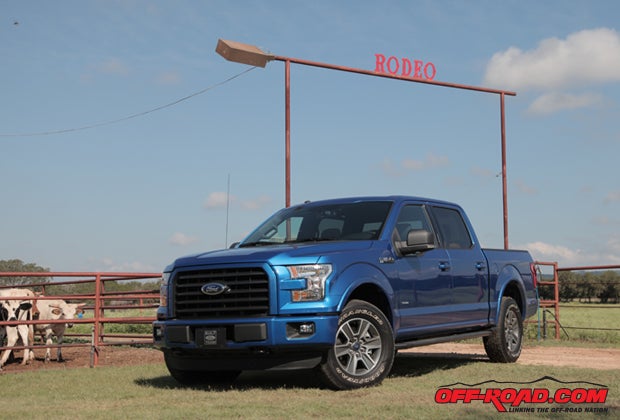
Thereís a fine line between making too many changes and being proactive enough to be considered cutting-edge. When youíve produced the best-selling truck for the past 37 years, changing the formula could be disastrous. For 2015, Ford has built an all-new F-150 highlighted by a new aluminum body and redesigned frame. Hoping to avoid becoming the next New Coke, Fordís investments in weight savings could either pay off handsomely or dethrone the king of the half-ton truck market.
Lighter, Stronger, Faster?
Garnering the most headlines for the new F-150, and for good reason, is Fordís move to an aluminum body. The shift shaves about 700 pounds off the new truck, depending upon the model. The military-grade aluminum may be lighter, but Ford reminded us that the lighter material allowed them to make the frame thicker than a comparable steel frame. While passing around lightweight pieces of the new frame at the press introduction in San Antonio, Texas, engineers also noted that the F-150 is stronger than before due to its riveted seam construction and the use of high-strength adhesives. Also aiding in frame strength is Fordís proprietary heat treatment to the aluminum in sections like the A-pillar tubes and B-pillar components.
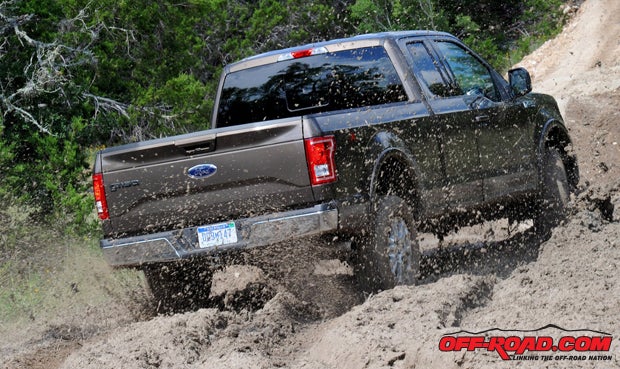
Aside from shedding extra pounds from the body, Ford also engineered a new fully boxed, ladder-style frame that actually features more steel in its construction Ė 23 percent more than the 2014, to be exact. With a new frame that features 77 percent high-strength steel this change might seem counterproductive to the aluminum weight loss of the body, but Ford engineered the frame to not only be stronger but also 60 pounds lighter than the previous model.
Get the Flash Player to see this player. |
The changes for the new truck donít stop at weight savings, however, and the new F-150 has much more invested than the 6 million it took to rebuild Steve Austin. An overall figure wasnít given on the amount Ford has poured into the F-150 (and it likely never will be), but one Ford representative said that retooling and training at production plants alone was in the half-billion range. We know this is just a fragment of Fordís investment into the new truck, so donít think those winning lottery numbers will afford you the chance to engineer a better half-ton.
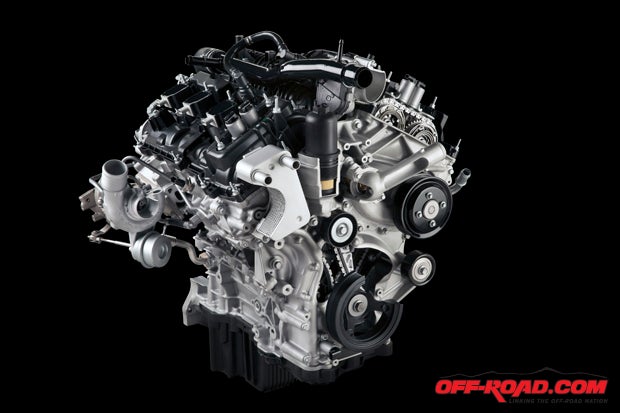
What compliments the weight savings are engine options designed to offer the capability truck buyers expect while providing the fuel economy that modern times require. With a significantly improved power-to-weight ratio, Ford has moved away from its 6.2-liter V8 in 2015. There are four engine options for the new F-150, including two naturally aspirated motors in the 3.5-liter V6 (283 hp, 255 lb.-ft.) and the 5.0-liter V8 (385 hp, 387 lb.-ft.), while the 3.5-liter EcoBoost V6 will return (365 hp, 420 lb.-ft.) to provide a maximum tow capacity of 12,200 lbs.
New to the 2015 model is a 2.7-liter Ecoboost V6 (325 hp, 375 lb.-ft.) that provides a max tow rating of 8,500 pounds. Ford hails this motor to be the most fuel efficient of the bunch in spite of its impressive numbers. The 2.7L also features Fordís first use of compacted graphite iron in a gasoline engine for the upper cylinder block. The stronger CGI material is used in its Ford race motors and its 6.7-liter Power Stroke diesel, and itís perfect for the 2.7L since it allows for thinner wall construction and tighter tolerances in the engineís design without sacrificing durability. The 2.7L EcoBoost also features Fordís first use of its Start/Stop technology in a truck, which will shut off the engine at stop lights or when idling provided the truck is not Tow/Haul mode or 4WD.
The 3.5-liter N/A V6 will be the base model engine, and pricing options above base are as follows: $795 more for the 2.7-liter EcoBoost (with a $300 incentive at launch), $1595 more for the 5.0-liter V8, and $1995 more for the 3.5-liter EcoBoost.
Ranger No More
With no mid-sized truck offering, Ford is looking to offer enough options in the F-150 to satisfy nearly every truck buyer. There are three cab options available on the 2015, including: the Regular Cab, with 6.5-ft. bed and 8-ft. bed options; the Super Cab (extra-cab), with 6.5-ft. bed and 8-ft. beds; and the Super Crew (four-door) with options for a 5.5-ft. bed and 6.5-ft. bed. Trim levels for the í15 include XL, XLT, Lariat, Platinum and King Ranch.
If thereís any question about Fordís confidence in its new F-150, look no further than its payload capacity. The quick-fast diet of the F-150 not only provides it with better power-to-weight ratio and improved fuel economy, but the reduction in weight also allows for larger payload capacities. For instance, the 3.5-liter V6 Ti-VCT V6 offers a maximum payload of 1910 lbs., the 2.7L Eco offers 2,250 lbs., the 3.5L Eco 3,180 lbs. and the 5.0L V8 3,330 lbs. That means max payload is up 220 lbs. over last year's model for a regular cab 4x2 with the 5.0 V8, for example. So while Ford reduced weight on the F-150, it still impressively managed to offer best-in-class payload and towing power.
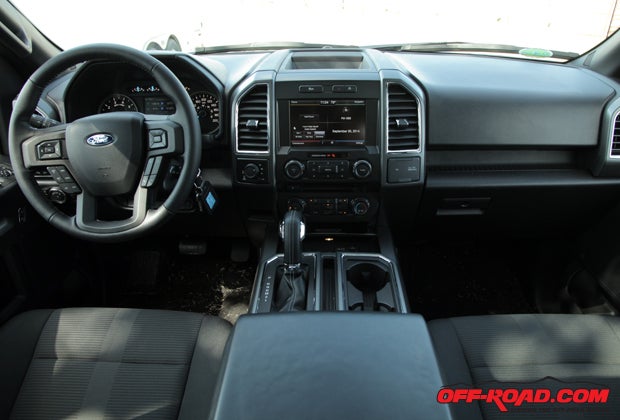
Inside the New F-150
Itís not all window dressing for the F-150, as several changes were made to the interior of the all-new 2015 truck. First off, the cab was widened by 2 inches and the roof was opened up slightly for added headspace. The backseat passengers get additional legroom via improved sculpting of the front seatbacks. Attention was also paid to the armrests on the front doors, which were lowered slightly and angled for improved ergonomics for resting an arm on the windowsill.
New to the 2015 F-150 is a unique design to the cabin entry on SuperCab models where the rear door opens a full 170 degrees for easier entry and exit of the truck. Loading an unloading gear into SuperCab and Crew Cab models also is made easier due to the truckís fully flat rear-load floor. More storage is featured throughout the new F-150 compared to the previous generation, including a newly designed center console that offers space for tablets and laptops. For charging electronics and/or making sure the kids are entertained during long road trips, there are 110 outlets available on the front dash as well as in the backseat of the Crew Cab models.
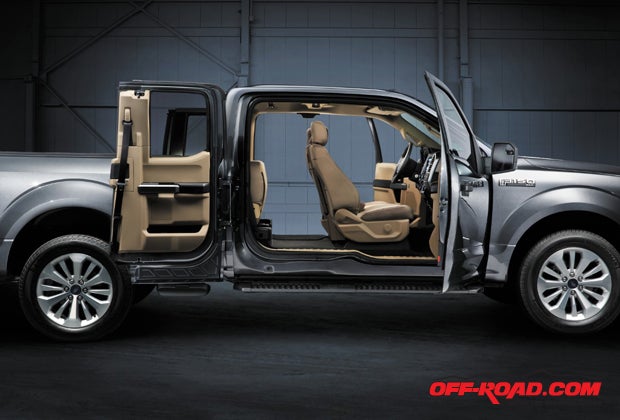
The twin-panel moonroof is quite unique and allows plenty of light to enter the cab. A newly designed 8-inch productivity screen (i.e.: instrumentation panel) provides a plethora of vehicle functions and settings, such as towing and off-road info, trip/fuel data and more. The 8-inch display is controlled via buttons on the steering wheel, which is nicely designed in terms of appearance but the number of buttons can make you more confused than Sandra Bullock trying to locate the power button in a Chinese escapte pod so she can get back to Earth.
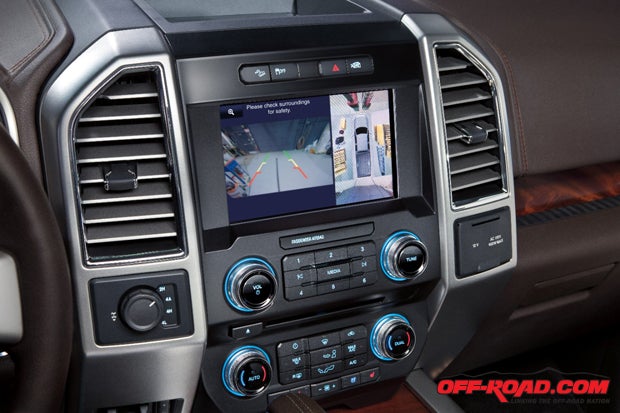
To set the F-150 apart from the competition, Ford also includes a number of class-exclusive features including its 360-degree camera with split-view display, which uses four exterior cameras to provide a birdís-eye view of the truck to aid in parking, better visibility when backing up, and it can help navigate tight roads or trails where clearance is minimal. The Dynamic Hitch Assist function is another cool feature that uses steering wheel angle in the rearview camera display to aid in lining up the truck to a trailer without the need of another person. Adaptive cruise control and Active Park Assist are new class exclusives on the F-150, but itís hard to ignore the new contour massaging seats Ė yes, that really is a new feature.
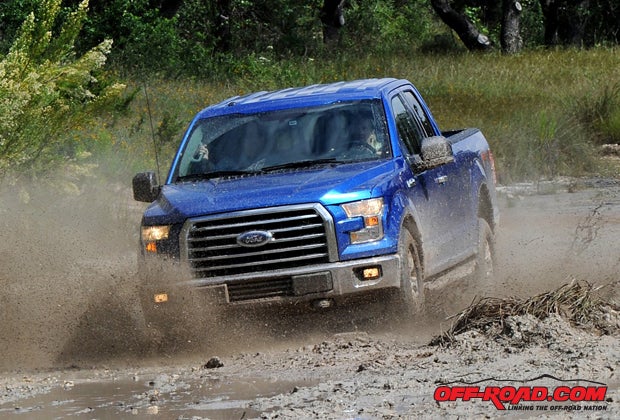
Testing The Mettle of Fordís New Metal
To prove that the new F-150 wonít fold up like a cheap can of soda, or more importantly that it wonít aggravate its loyal buyers by introducing an inferior product in the spirit of New Coke, Ford hails the F-150 as tougher than ever. Now it's time for the taste test!


 Your Privacy Choices
Your Privacy Choices